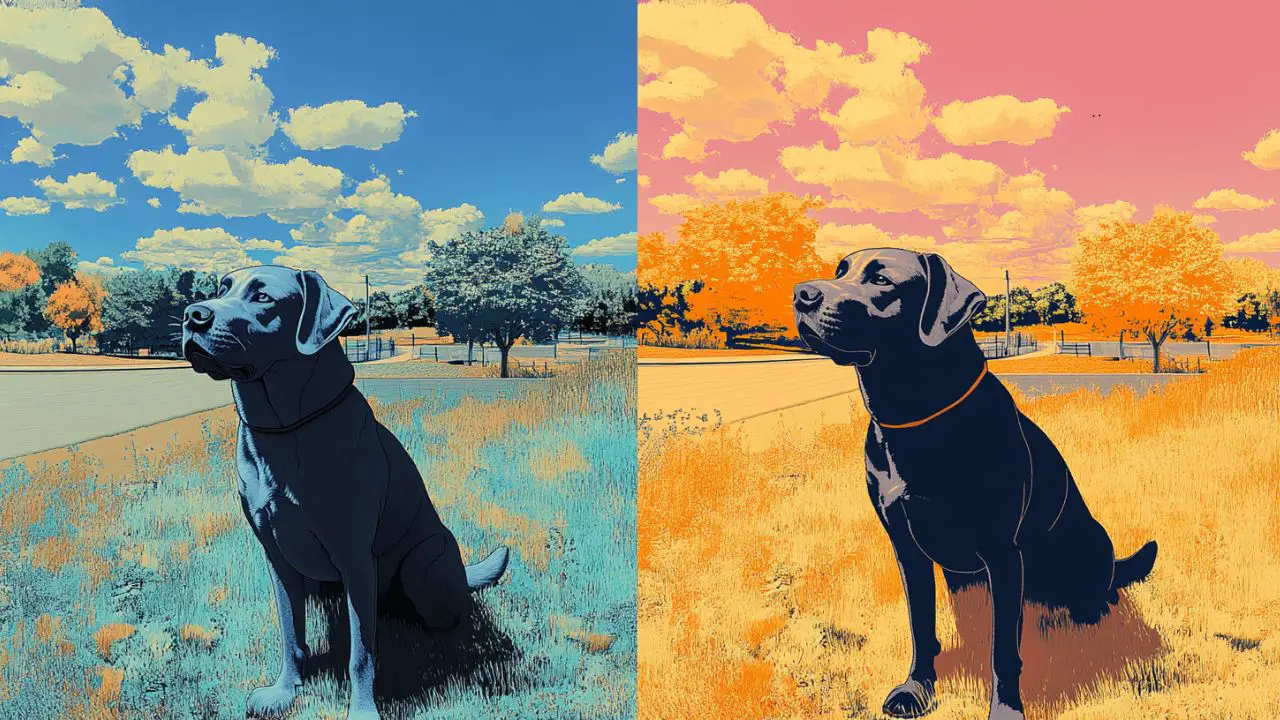Have you ever wondered how your furry friend perceives the world around them?
While dogs are known for their keen sense of smell and hearing, their vision is often a topic of curiosity and misconception.
Contrary to popular belief, dogs don’t see the world in black and white, but their color perception is quite different from ours.
Let’s delve into the fascinating world of canine color vision and explore what our four-legged companions actually see.
The Basics of Color Vision
To understand canine color vision, we first need to grasp the basics of how color vision works.
In both humans and dogs, color perception is determined by specialized cells in the retina called cones.
These cones are sensitive to different wavelengths of light, allowing us to perceive various colors.
Humans typically have three types of cones, which enable us to see a wide spectrum of colors.
Dogs, on the other hand, have a different cone structure that affects their color perception.
Dichromatic Vision in Dogs
Dogs are what scientists call dichromats, meaning they have two types of cones in their retinas.
This is in contrast to humans, who are typically trichromats with three types of cones.
The two types of cones in a dog’s eyes are sensitive to blue and yellow wavelengths.
This means that dogs can perceive blues, yellows, and combinations of these colors.
However, they struggle to distinguish between green, yellow, and red, which can appear similar to them.
The Canine Color Spectrum
Based on scientific research, we can approximate what the world looks like through a dog’s eyes.
Where humans see vibrant reds, greens, and oranges, dogs perceive more muted yellow and blue tones.
A lush green lawn might appear more yellowish to a dog, while a bright red ball might look more brownish or gray.
Purple objects may look similar to blue ones from a dog’s perspective.
This doesn’t mean dogs can’t see these objects; they just perceive them differently than we do.
The Myth of Black and White Vision
The long-standing myth that dogs see only in black and white is completely false.
While their color perception is more limited than humans’, dogs do see colors, just in a different way.
This misconception likely arose from early studies on animal vision that were misinterpreted over time.
Modern research has conclusively shown that dogs have color vision, albeit different from humans.
Understanding this helps us better appreciate how our canine friends experience the world.
Advantages of Canine Vision
While dogs may not see the full spectrum of colors that humans do, their vision has unique advantages.
Dogs have more rod cells in their retinas, which are responsible for detecting motion and light levels.
This gives them superior vision in dim light and allows them to detect even slight movements.
Dogs also have a wider field of vision than humans, thanks to the position of their eyes.
These adaptations make dogs well-suited for hunting and detecting potential threats, even in low light conditions.
Color Vision and Dog Behavior
Understanding canine color vision can help explain certain behaviors and preferences in dogs.
For example, dogs may have difficulty distinguishing between a red toy and the green grass it’s thrown onto.
This is why many dog toys are made in blue or yellow colors, which are more easily visible to canine eyes.
When training dogs or choosing toys, considering their color perception can enhance their experience.
It’s not that dogs can’t see red objects, but blue or yellow ones might be more visually stimulating for them.
Breed Differences in Vision
While all dogs have dichromatic vision, there can be slight variations between breeds.
Some breeds may have slight differences in the exact wavelengths their cones are sensitive to.
Additionally, the shape and position of a dog’s eyes can affect their overall visual acuity and field of view.
Breeds with flatter faces, like Pugs or Bulldogs, may have a slightly different visual perspective than long-nosed breeds.
These differences are generally minor but contribute to the unique way each dog experiences the world.
How Dogs Compensate for Limited Color Vision
Despite having a more limited color perception, dogs navigate their world remarkably well.
They rely heavily on their other senses, particularly their extraordinary sense of smell.
Dogs also pay close attention to brightness levels, shapes, and movements to interpret their environment.
Their ability to detect subtle changes in body language and facial expressions compensates for what they lack in color vision.
In many ways, a dog’s world is rich with sensory information that we humans might not even notice.
Implications for Dog Owners
Understanding canine color vision can help dog owners create better environments for their pets.
When choosing toys or training aids, opt for blues and yellows for maximum visibility.
Consider using contrasting colors in your dog’s living space to help them navigate more easily.
Remember that your dog’s perception of the world is different, but not necessarily inferior to yours.
This knowledge can enhance the way you interact with and care for your canine companion.
Conclusion
While dogs may not see the world in the same vibrant hues that humans do, their visual perception is uniquely adapted to their needs.
Understanding canine color vision helps us appreciate the special way our furry friends experience the world around them.
By considering their visual capabilities, we can create more enriching environments and strengthen our bonds with our canine companions.
Next time you play fetch with a yellow ball on a sunny day, remember – your dog sees that moment in a way that’s all their own.
Share this article on Facebook to help fellow dog lovers understand the fascinating world of canine color vision!
SHARE now with your friends!
- Hero Farm Dog Survives Epic Battle with Coyote Pack - December 9, 2024
- The 10-Minute Bedtime Routine That Changed My Dog’s Sleep Forever - November 29, 2024
- Creating a Safe Space for Nervous Pets: Your Guide to Pet-Friendly Havens - November 25, 2024

